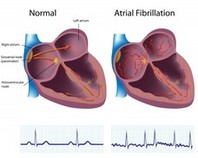
In most situations, the onset is not associated or triggered by severe exertion. The immediate risk of MI increases 6 to 30 folds in sedentary people.
An increased suspicion for a possible MI should be maintained especially when it comes about the following groups in the presence of typical symptoms: cocaine users, elderly people, those with a history of heart failure, dementia, diabetes mellitus, hypercholesterolaemia or those with a strong family history of early coronary disease (any first-degree male relative aged 45 years or younger or any first-degree female relative aged 55 years or younger who experienced a MI).
Preceeding symptoms (within days before an acute attack):
- fatigue
- chest discomfort
- malaise
Typical characteristics of the chest pain in MI:
- intense and unremitting for 30 - 60 minutes
- felt behind the sternum bone and often radiating into the jaw, neck and down to the ulnar aspect of the left arm
- most commonly described as a retrosternal pressure sensation or sometimes as a squeezing, aching or burning sensation
- in certain individuals the symptoms are those of an indigestion or of fulness or gas (digestive symptoms)
Accompanying symptoms and signs:
- excessive anxiety (sensation of imminent death)
- excessive perspiration (excessive sweating)
- increased and/or irregular pulse (sometimes felt like palpitations)
- increased respiratory rate
- coughing, wheezing and production of aerate (bubbly) sputum (phlegm)
- increased temperature (fever of around 38C) for the first 24 - 48 hours


 RSS Feed
RSS Feed